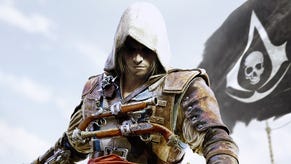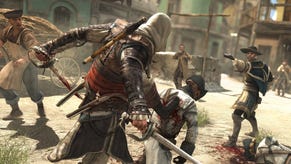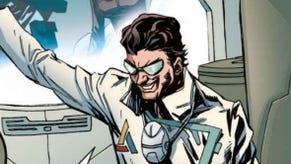Assassin's Creed 4: Black Flag ending analysis
Juno what it is yet?
Love it or love to moan about it, the latest annual chapter in the Assassin's Creed franchise has once again advanced the increasingly labyrinthine narrative, provided answers to a number of outstanding mysteries and dropped new clues as to where the series may be heading.
Let's recap. A year ago Assassin's Creed 3 ended with the death of dull series protagonist Desmond, who sacrificed himself to save the world from a giant solar flare and tie up a bunch of loose plot strands in the process. But his actions released the entombed spirit of Juno, a malevolent member of the long-dead First Civilisation race. She mopped up the solar radiation and saved the planet (yay!) but was then free to roam the wires of Earth's technology, hunting for corporeal form like an electronic Voldemort (boo).
With the series' long-running apocalypse plot finally concluded and Desmond's present day antics rounded off, Assassin's Creed 4 is mercifully free to tell a tale of its own. Naturally, it builds on previous events in the Creedverse, but it postpones Juno's apparently imminent arrival to an event still a ways off - she's still too weak, a manifestation of her explains. Her role is relegated to that of a cameo appearance - likewise the ongoing antics of surviving Assassin sidekicks Shaun and Rebecca. Instead, Black Flag manages to weave a surprisingly self-contained yarn with strong ties between the narrative of historical protagonist Edward Kenway and the game's modern day sections set within Abstergo Entertainment.
In the early 1700s, privateer-turned-pirate Kenway (grandfather to AC3's grumpy Connor) is distracted from his lucrative life stealing ships when he learns of The Observatory, a mystical device that can spy on anyone anywhere in the world using a sample of their blood - it's basically the First Civilisation's version of PRISM.
Eager for the riches it might offer him, Kenway seeks the only man who knows its location: a mysterious sage named Bartholomew Roberts. The heroic Assassins and scheming Templars are after the device too, but Kenway and the elusive Roberts remain third parties to the warring sides for the majority of the game. Adding an extra layer of confusion is the fact that Roberts is only the latest in a long line of identical sages, a revelation Kenway discovers after finding an ancient statue that also sports Roberts' eye-catching moustache.

In the present, meanwhile, you play as an anonymous researcher reliving Kenway's memories within the newly-formed (and very meta) video game developer Abstergo Entertainment. The company's secret Templar overlords become very excited as you uncover clues to the Observatory's whereabouts, while a mysterious third party passes copies of your findings to the present day Assassins. This modern day third party is "John from IT", revealed at the end of the game to be yet another version of the moustachioed sage, and - here comes your final level of WTF - a human form of Aita, the First Civilisation husband of Juno, who died during her experimentation and who is now repeatedly reborn throughout history, like Nintendo's many versions of Link but with bad facial hair.
We've heard of Aita before, specifically in Juno's conversations with Desmond during Assassin's Creed 3. He volunteered as a test subject for Juno's bio-engineering research during the last days of the First Civilisation, during his race's doomed attempts to survive the impending Catastrophe (the solar flare that wiped out the First Civ for good, and left humans as the dominant survivors). But though the experiment's final goal failed (and Aita was euthanised after being left comatose), Juno's ability to still exist in some form today shows that she achieved at least some form of transcendence. Aita's survival as a continually reborn human appears to be another similarly last-ditch effort to survive. How Juno was able to insert his memories into humanity's lineage is uncertain, but we learned in Brotherhood that she was successful in copying over First Civilisation abilities in a similar fashion - seen in the sixth-sense power that the Assassins term Eagle Vision.
One plot thread left dangling is the Observatory's missing cache of blood vials, presumably stolen and hidden somewhere by Roberts. The sage had previously pointed out their significance to Kenway and identified them as containing samples from First Civilisation individuals. "These cubes contain the blood of an old and ancient people. A wonderful race, in their time," he explains. "The blood in those vials is not worth a single reale to anyone anymore. It may be again, one day. But not in this epoch."
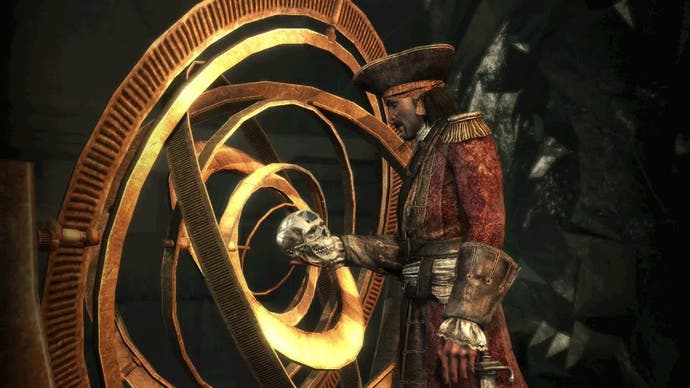
There's already a strong parallel between the Observatory's ability to spy on individuals using their blood and Abstergo Entertainment's increasingly advanced Animus technology, which can now relive an individual's memory by sequencing their DNA. The ability to relive First Civilisation experiences via the Animus would be a powerful tool, and may explain "John's" placement within Abstergo, especially considering his attempt to insert Juno within the player's mind. If that had worked, would more attempts have followed with other First Civilisation members, using the Observatory's vials?
Certainly, "John's" actions suggest a careful plan to help Juno return, and hint at some form of prior arrangement between the two. "I envy you! It was her wish that I be here to greet her," he screams at the player when his attempt to revive her fails. "John" is also the author of a mysterious document, the Manifesto of the Instruments of the First Will, a text which talks of 'True Templars' and their wish to help the First Civilisation return to power. This may seem an odd concept for the Templars, an organisation bent on controlling humans themselves, but it would fit with their desire for order, and for humankind to be shepherded and calmed by an overseeing force. "John" references this document again with his last words - "Guide me into the grey, beloved! I am your instrument!" - before allowing himself to be shot dead by Abstergo. Roberts previously implored Kenway to burn his body after death to stop the Templars obtaining a sample of his blood. Now, surrounded by Abstergo, he basically hands his memories to them on a platter.
This means the Templars now have access to Aita's latest modern day memories and those of his First Civilisation origins. It certainly seems like an intentional assist for their cause, so why help the Assassins, too? Well, it's been shown previously that Juno has regularly pitted the rival Assassins and Templars against each other for her own gain, and perhaps the same is true here. As in the real world, the threat of competition will spur the development of technology ever faster, something Juno may well wish for Abstergo, so by keeping the Assassins in the loop neither side can become complacent. The modern day Assassins may seem like they've gotten the lesser reward at the end of Black Flag, until you remember the disappearance of Abstergo Entertainment exec Olivier Garneau. It seems highly likely that his mysterious departure was at the hands of the Assassins, with "John" working behind the scenes to facilitate the mission.
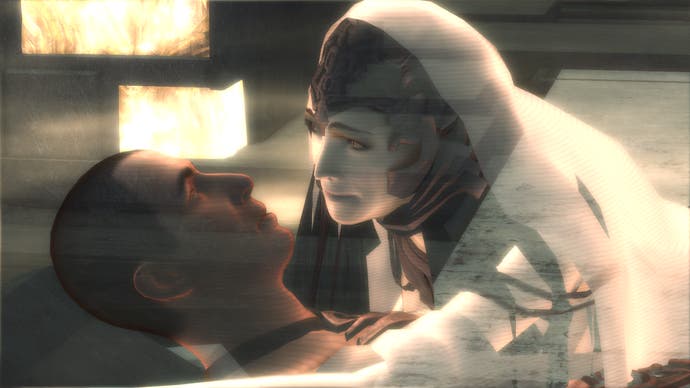
The ending to Edward Kenway's story is thankfully a great deal more straightforward, and a surprisingly mature conclusion for a series all about stabbing people in the neck. After Kenway's game-long personal journey of realising he was a bit of a dick, he finally gives up a life of piracy to return to England with his newly-discovered daughter. It only took the deaths of his wife, all of his close friends and his hot, cross-dressing Assassin love interest for him to decide. Edward's later life has already been well documented in the excellent tie-in novel Forsaken, which I won't spoil but which bridges the gap between Assassin's Creed 3 and 4. The game's epilogue, set in the same theatre where Assassin's Creed 3 begins, gives us our first glimpse at Kenway's young son Haytham on the day he meets Reginald Birch, a figure with huge significance in Edward's later life.
It's a wise move for Black Flag to wrap up our exploits with the Kenway dynasty - it allows next year's historical setting to again start with an enticingly blank canvass, while nudging along the series' modern day plot and leaving it several options to explore. Ubisoft has previously told Eurogamer that an end to the Assassin's Creed series does exist, but, freed from explaining everything through the eyes of a particular character, Black Flag has perhaps the best balance of modern day and historical storylines of the franchise to date. There's an increasingly-deep meta-story for those who want it, and it simply enriches the historical narrative as a framing device for those who don't.







